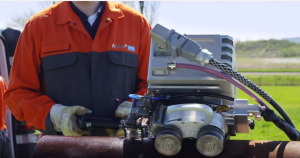RTD IWEX: A new way of UT defect detection and presentation
At the forefront of the development of new techniques and customized solutions, Applus+ has pioneered the use of a large array of non-destructive investigation methods. After years of development, Applus+ RTD introduced IWEX, a novel ultrasonic testing method which shows great potential in both defect detection, sizing, positioning and characterization.
IWEX (Inverse Wavefield EXtrapolation) refers to a methodology to construct images from measurements with ultrasonic waves. The ultrasonic images can be compared with scans from unborn babies, although the processing of IWEX images is done differently. Roughly, the IWEX system consists out of a computer, a box with ultrasonic hardware connected with a cable to the computer, a set of ultrasonic array probes and a manipulator to make an (semi) automated scan along the weld or other component.
The RTD IWEX technology is a platform that can be utilized for many different applications of non-destructive testing. At the moment, the main applications for IWEX are long-seam inspection of in-service gas pipe lines (mainly in North America) and new construction girth weld inspection. Other applications that are under development are the inspection of welds at new constructed LNG tanks, corrosion mapping, inspection of heavy wall cast steel weld in energy and nuclear plants.
The main advantage of the RTD IWEX technology is that the inspection result is presented in a comprehensive and intuitive 2D or 3D image that illustrates defects whereby defect properties (location, orientation, size, etc.) can be determined more accurately than other NDT technologies. The 3D images can be viewed interactively using software (a viewer program but also a .pdf site report) to rotate and zoom the images.
The improved sizing accuracy obtained by IWEX imaging will lead to better interpretation of inspection results. This can save unnecessary rejected welds due to poor interpretation and over conservatism of rejection criteria. Especially for off-shore pipeline projects, saving welds means saving significant costs.
Unlike other competing technologies, the IWEX methodology does not require any knowledge about the weld bevel design, nor does it rely on project specific calibration blocks. Instead, an IWEX set-up can be configured using a standardized reference block design. The advantage of this is that the lead time for work preparation is reduced significantly and it is no longer on the critical path of the pipeline project. This will also save costs and it enables the required flexibility of ‘short track’ projects.
RTD IWEX imaging is unique in its kind because of the processing speed which is made real-time. Only a few other technologies are known that are similar to IWEX, however they have not reached the stage of maturity of IWEX yet. Furthermore, the IWEX technology was subjected to an extensive qualification program following the DNV FS101 specification of off-shore girth weld inspection, which is a prerequisite to enter this market.
As part of the market introduction process, round robin tests and field trials are being conducted in cooperation with clients. For the girth weld application we have worked together with TransCanada during the Chinchaga Lateral Loop 3 pipeline project. The objective was to demonstrate the IWEX technology under field conditions that are common for on-shore pipeline construction in Canada. This means that the equipment is able to run under extremely low temperatures and can keep up with the production rate (about 4-5 minutes per weld).
Another project to demonstrate the performance of the IWEX technology was conducted in parallel to the validation program of the Total Martin Linge project. In this type of validation program, the equipment is subjected to a series of tests such as temperature, stability and consistency tests. Furthermore, a number of welds with seeded defects are scanned to determine the sizing accuracy of the system.
At the moment, more of these parallel validation programs are ongoing, such as Kaombo project and the Edradour project.
